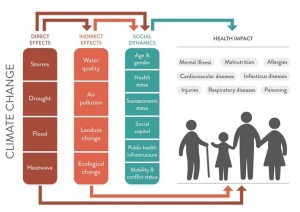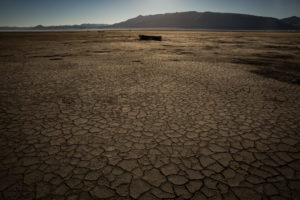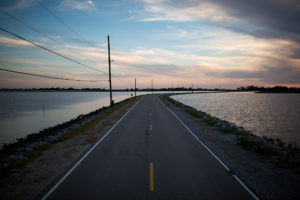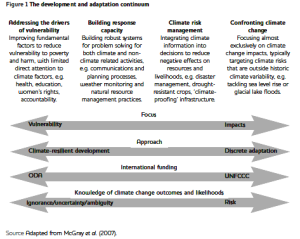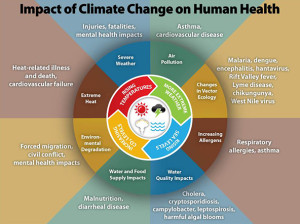What you will find on this page: LATEST NEWS; places too hot to live in; uninsurable nation – Australia; retreat not as easy as first thought; toughest question – who gets saved? inland cities sinking; not only the poor feeling effects of climate change; record losses as global warming worsens; development threat mapped; do we ever learn from history; health & climate change (video); population data; climate refugees; displaced persons; born into danger (video); global poverty; health issues; Doctors for the Environment Australia; information & resource sites; also refer to page “impacts observed & projected” as the issues are closely related
Latest News 2 September 2024, The Conversation: ‘It’s time to give up on normal’: what winter’s weird weather means for the warm months ahead. Heavy winds struck south-east Australia over the weekend as a series of cold fronts moved across the continent. It followed a high fire danger in Sydney and other parts of New South Wales last week, and a fire in south-west Sydney that threatened homes. The severe weather rounds out a weird winter across Australia. The nation’s hottest ever winter temperature was recorded when Yampi Sound in Western Australia reached 41.6C on Tuesday. Elsewhere across Australia, winter temperatures have been way above average. We can look to the positives: spring flowers are blooming early, and people have donned t-shirts and hit the beach. But there’s a frightening undercurrent to this weather. Earth’s climate has become dangerously unstable, and it’s only a matter of time before we get the bad combination of hot and dry weather, strong winds and a spark. None of this should come as a surprise. The sooner we stop expecting Australia’s weather to be “normal”, the sooner we can prepare for life in a wild climate. The green is deceiving The landscape around Sydney – and in fact, across much of south-east Australia – is very green at the moment. That’s because we’ve had a couple of years of good rains which triggered an explosion of vegetation growth. The below NASA satellite image reveals the picture in stark detail. It’s certainly lush out there at the moment. But the problem with climate change is that weather conditions can turn on a dime. This August was a case in point. At month’s end, much of Australia was hit by a record-breaking heatwave and damaging winds – conditions that can dry out a green landscape with devastating efficiency, turning it into fuel for a bushfire. The dangerous fire weather that struck Sydney this week came as a surprise to many. But in reality, these abnormal conditions are the new normal. We must open our minds to this, if we want to be prepared. Read more here 21 August 2024, Climate Home News: In a world first, Grenada activates debt pause after Hurricane Beryl destruction. More creditors are agreeing to suspend debt payments in the wake of weather disasters, but experts say greater financial relief will be needed. As Hurricane Beryl swept through the Caribbean in early July, its deadly passage left a trail of destruction across the island nation of Grenada. Winds of up to 240 kilometres per hour flattened entire neighbourhoods and toppled power and communication lines, causing damage equivalent to a third of the country’s annual economic output, according to early government estimates. Many Grenadians cast their minds back 20 years when a similarly powerful storm – Hurricane Ivan – brought the island state to its knees, triggering a vicious circle of financial distress that eventually led to a debt default. But, unlike in 2004, officials this time could deploy a tool that has been widely discussed in climate circles to provide financial help in the wake of fierce storms: hurricane clauses built into its agreements with international creditors. Grenada last week became the first country in the world to use such a provision in a government bond which will allow it to postpone debt repayments to private investors, including US investment firms Franklin Templeton and T. Rowe Price. The move will save the Caribbean island nation a total of around $30 million in payments due this November and in May next year. While the money owed will be added to future bills, in the meantime the cash injection will help fund immediate recovery efforts and keep essential services like healthcare and education running, a senior official in Grenada’s Ministry of Finance told Climate Home. The government is now “in talks” about triggering similar clauses with other creditors. Fighting the debt trap. Grenada’s use of debt suspension clauses will be seen as a litmus test for their effectiveness in shoring up disaster-hit economies, as major international financial institutions like the World Bank promise to offer them more widely to climate-vulnerable countries. Read more here 20 August 2024, The Conversation: The overshoot myth: you can’t keep burning fossil fuels and expect scientists of the future to get us back to 1.5°C. Record breaking fossil fuel production, all time high greenhouse gas emissions and extreme temperatures. Like the proverbial frog in the heating pan of water, we refuse to respond to the climate and ecological crisis with any sense of urgency. Under such circumstances, claims from some that global warming can still be limited to no more than 1.5°C take on a surreal quality. For example, at the start of 2023’s international climate negotiations in Dubai, conference president, Sultan Al Jaber, boldly stated that 1.5°C was his goal and that his presidency would be guided by a “deep sense of urgency” to limit global temperatures to 1.5°C. He made such lofty promises while planning a massive increase in oil and gas production as CEO of the Abu Dhabi National Oil Company. We should not be surprised to see such behaviour from the head of a fossil fuel company. But Al Jaber is not an outlier. Scratch at the surface of almost any net zero pledge or policy that claims to be aligned with the 1.5°C goal of the landmark 2015 Paris agreement and you will reveal the same sort of reasoning: we can avoid dangerous climate change without actually doing what this demands – which is to rapidly reduce greenhouse gas emissions from industry, transport, energy (70% of total) and food systems (30% of total), while ramping up energy efficiency. A particularly instructive example is Amazon. In 2019 the company established a 2040 net zero target which was then verified by the UN Science Based Targets initiative (SBTi) which has been leading the charge in getting companies to establish climate targets compatible with the Paris agreement. But over the next four years Amazon’s emissions went up by 40%. Given this dismal performance, the SBTi was forced to act and removed Amazon and over 200 companies from its Corporate Net Zero Standard. This is also not surprising given that net zero and even the Paris agreement have been built around the perceived need to keep burning fossil fuels, at least in the short term. Not to do so would threaten economic growth, given that fossil fuels still supply over 80% of total global energy. The trillions of dollars of fossil fuel assets at risk with rapid decarbonisation have also served as powerful brakes on climate action. Overshoot: The way to understand this doublethink: that we can avoid dangerous climate change while continuing to burn fossil fuels – is that it relies on the concept of overshoot. The promise is that we can overshoot past any amount of warming, with the deployment of planetary-scale carbon dioxide removal dragging temperatures back down by the end of the century. This not only cripples any attempt to limit warming to 1.5°C, but risks catastrophic levels of climate change as it locks us in to energy and material-intensive solutions which for the most part exist only on paper. To argue that we can safely overshoot 1.5°C, or any amount of warming, is saying the quiet bit out loud: we simply don’t care about the increasing amount of suffering and deaths that will be caused while the recovery is worked on. The way to understand this doublethink: that we can avoid dangerous climate change while continuing to burn fossil fuels – is that it relies on the concept of overshoot. The promise is that we can overshoot past any amount of warming, with the deployment of planetary-scale carbon dioxide removal dragging temperatures back down by the end of the century. This not only cripples any attempt to limit warming to 1.5°C, but risks catastrophic levels of climate change as it locks us in to energy and material-intensive solutions which for the most part exist only on paper. To argue that we can safely overshoot 1.5°C, or any amount of warming, is saying the quiet bit out loud: we simply don’t care about the increasing amount of suffering and deaths that will be caused while the recovery is worked on. Read more here 21 November 2023, The Conversation: Denial is over. Climate change is happening. But why do we still act like it’s not? Climate-fuelled disaster is now front-page news, as record-breaking floods, fires, droughts and storms keep arriving. The damage done by climate change is systemic and pervasive, resonating through our communities, economies and environments. It manifests in many ways, from empty spaces in supermarket shelves to houses left unlivable after floods, anxious communities, collapsing ecosystems and emergency services stretched to capacity. Climate researchers initially assumed that if you gave people the right information, we would act on it. Burning fossil fuels comes with severe consequences – so let’s phase out fossil fuels. But they found out very quickly this was not the case. For many people, it triggered cognitive dissonance, where they knew climate change was happening but acted like it wasn’t. After all, many people still smoke, even though they know it is bad for their health. And many of us still fly to Italy – even though we know how many extra tonnes of carbon dioxide we put into the atmosphere. But why is it so easy to understand but not act? Change seems hard, doing nothing is easy It’s because of public and private narratives we have grown up with. Our expectations of life are geared towards wanting comfort and stability. This means not everyone has developed the ways of thinking needed to deal with the impacts (such as natural hazards) we are now facing. Sudden changes caused by these – such as the loss of a home – are almost invariably shocking and can create a sense of disbelief. How could this be? When do we get back to normal? Surely it won’t happen again? Our research on systemic risks such as climate change adaptation suggests this disconnect is common. Because we expect and hope for stable normality, we find it hard to truly believe the changes we are seeing will continue. Read more here End Latest News 9 March 2022, NASA Climate: As Earth’s climate warms, incidences of extreme heat and humidity are rising, with significant consequences for human health. Climate scientists are tracking a key measure of heat stress that can warn us of harmful conditions. Because the heat index requires calibration, it’s a somewhat subjective measurement. In fact, different countries use different versions of it. For this reason, scientists conducting global climate studies are looking increasingly at another measure of heat stress called wet-bulb temperature. Wet-bulb temperature is the lowest temperature to which an object can cool down when moisture evaporates from it. The lower the wet-bulb temperature, the easier it is for us to cool down. It measures how well our bodies cool down by sweating when it’s hot and humid, and tells us if conditions may be harmful to our health, or even deadly. Read more here May 2022, Climate Council Report: UNINSURABLE NATION: AUSTRALIA’S MOST CLIMATE-VULNERABLE PLACES. Climate Change, driven by the burning of coal, oil and gas is supercharging our weather systems. While climate change affects all Australians, the risks are not shared equally. In the most extreme instances, areas may become uninhabitable. Worsening extreme weather means increased costs of maintenance, repair and replacement to properties – our homes, workplaces and commercial buildings. As the risk of being affected by extreme weather events increases, insurers will raise premiums to cover the increased cost of claims and reinsurance. Insurance will become increasingly unaffordable or unavailable in large parts of Australia due to worsening extreme weather. This report outlines the top 20 most at-risk federal electorates to climate change-related extreme weather events, providing a brief profile of the top 10. The report also outlines the most at risk electorates for each state and territory. Check out our Climate Risk Map to see if your area is at risk. Link to report here. America’s Last-Ditch Climate Strategy of Retreat Isn’t Going So Well The Toughest Question in Climate Change: Who Gets Saved? In January, the government announced its decision: Isle de Jean Charles would get full funding for a move. Newtok would get nothing. “Don’t get me wrong — I don’t want nothing against Louisiana,” Romy Cadiente, Newtok’s relocation coordinator, told me by phone. And yet: “Surely you would have thought somebody as far along in the project as we are, we would have got some type of consideration.” The contest, called the National Disaster Resilience Competition, was the first large-scale federal effort to highlight and support local solutions for coping with climate change. It wound up demonstrating something decidedly less upbeat: The federal government is still struggling to figure out which communities should be moved, and when, and how to pay for it. Photo: Gabriel Bouys/AFP/Getty Images. Access full article here In the Pearl River Delta, breakneck development is colliding with the effects of climate change Climate change is not only affecting coastal areas – inland cities, like Mexico City are sinking It is not only the poor that are feeling the effects of climate change 26 November 2016, New York Times, Perils of Climate Change Could Swamp Coastal Real Estate. Homeowners are slowly growing wary of buying property in the areas most at risk, setting up a potential economic time bomb in an industry that is struggling to adapt. Real estate agents looking to sell coastal properties usually focus on one thing: how close the home is to the water’s edge. But buyers are increasingly asking instead how far back it is from the waterline. How many feet above sea level? Is it fortified against storm surges? Does it have emergency power and sump pumps? Rising sea levels are changing the way people think about waterfront real estate. Though demand remains strong and developers continue to build near the water in many coastal cities, homeowners across the nation are slowly growing wary of buying property in areas most vulnerable to the effects of climate change. A warming planet has already forced a number of industries — coal, oil, agriculture and utilities among them — to account for potential future costs of a changed climate. The real estate industry, particularly along the vulnerable coastlines, is slowly awakening to the need to factor in the risks of catastrophic damage from climate change, including that wrought by rising seas and storm-driven flooding. But many economists say that this reckoning needs to happen much faster and that home buyers urgently need to be better informed. Some analysts say the economic impact of a collapse in the waterfront property market could surpass that of the bursting dot-com and real estate bubbles of 2000 and 2008. The fallout would be felt by property owners, developers, real estate lenders and the financial institutions that bundle and resell mortgages. Read More here Record losses as global warming worsens 15 November 2016, Climate News Network, While governments continue to negotiate on climate change, meteorological scientists warn that the global warming situation is rapidly deteriorating. As summers get hotter, seas get warmer and extreme wind and rainstorms inflict ever-greater loss of human life and property, the World Meteorological Organisation (WMO) is trying to develop and early warning system for vulnerable countries and regions.In a report yesterday to governments at the UN’s COP22 climate talks in Marrakesh, Morocco, the WMO said that 2016 was almost certain to be the warmest year on record, and detailed the “considerable socio-economic losses in all regions of the world” that has resulted. The deadliest event so far in 2016 has been Hurricane Matthew, which was Haiti’s worst humanitarian disaster since the 2010 earthquake, killing 546 people and injuring 438. Petteri Taalas, the WMO secretary-general, said: “Another year, another record. The high temperatures we saw in 2015 are set to be beaten in 2016. Continued global warming “The extra heat from the powerful El Niño event has disappeared, but the heat from global warming will continue.” “In parts of Arctic Russia, temperatures were 6°C to 7°C above the long-term average. Many other Arctic and sub-Arctic regions in Russia, Alaska and northwest Canada were at least 3°C above average. We are used to measuring temperature records in fractions of a degree, and so this is different. “Because of climate change, the occurrence and impact of extreme events has risen. ‘Once in a generation’ heatwaves and flooding are becoming more regular. Sea level rise has increased exposure to storm surges associated with tropical cyclones.” Read More here 14 November 2016, The Guardian, ‘It was too hot, even to leave home’: stories from the world’s hottest year , From drought-hit Nigeria to wine-growing Finland, we hear from people whose lives have already been changed by a warming world. Nigeria: In the displacement camps of north-east Nigeria, most residents have the same answer for why 2.6 million people have been forced from their homes in this region. Russia: Rodion Sulyandziga, who runs the Moscow-based Center for Support of Indigenous Peoples of the North, says climate change is now one of the key challenges facing Siberia’s numerous indigenous communities. India: In the town of Phalodi, surrounded by the Rajasthani deserts of western India, the mercury hit 51C in May, the highest recorded temperature in Asia since 1956. Thailand: Thailand suffered its worst drought in two decades this year, focused in the country’s arid north-east where reservoirs are at record low levels. Brazil: For five years, the farmers of Poço Redondo have suffered from a drought that has devastated the crops of corn and beans on which they depend. 13 October 2015, Nature Conservancy,By 2050, the world’s population is projected to approach nine billion. With more people will come more developed land—a lot more. Urbanization, agriculture, energy, and mining put 20 percent of the world’s remaining forests, grasslands, and other natural ecosystems at risk of conversion by 2050. With that kind of expansion, there are sure to be harms—namely clean water, clean air, and biodiversity. To mitigate some of those risks, scientists and geographers at the Nature Conservancy have taken a crucial step by mapping the potential impact that human growth will have on natural lands. It’s the most comprehensive look to date at how major forms of development will take over fragile ecosystems, if left unchecked. Using publicly available global datasets, the researchers projected how terrestrial ecosystems would be affected by nine sectors: urban and agricultural expansion, fossil fuels (conventional oil and gas, unconventional oil and gas, and coal), renewable energy (solar, wind, and biofuels), and mining. They ranked the development potential for each sector on a relative scale, based on either “the amount of unexploited resources (i.e. for fossil fuels, renewables, and mining) or estimated future area expansion derived from past trends (i.e. for urban and agriculture).” To read more and access the maps go here 1 January 2016, Truthdig, So what was the most significant event of 2015? It wasn’t a single event. Rather, it was a worsening of something that started several years before. It was the fast-increasing, huge migration of immigrants—many running for fear of their lives—making their dangerous and often fatal way by land and across the Mediterranean, the Gulf of Aden, the Red Sea and the oceans of Asia. It is the greatest forced mass movement of refugees since World War II, caused by the confluence of civil war, brutal regimes, sectarian and ethnic hatred, and climate change all coming together in a world too weak and preoccupied to deal with such powerful forces..… While war is the biggest single force behind the mass migration, there are other causes, interrelated in complex ways. The best illustration of this is climate change. An organization that has been assisting refugees since 1951, the International Organization for Migration, reported that “Climate change is expected to trigger growing population movements within and across borders, as a result of such factors as increasing intensity of extreme weather events, sea-level rise and acceleration of environmental degradation. In addition, climate change will have adverse consequences for livelihoods, public health, food security, and water availability. This in turn will impact on human mobility, likely leading to a substantial rise in the scale of migration and displacement.” According to the organization, there are no reliable estimates of climate change-induced migration but 200 million people by 2050 is “the most widely cited estimate.” Read More here Do we ever learn from history? In 1991 I attended the World Women’s Congress for a Healthy Planet held in Miami (an international conference to place the women’s agenda into the Rio Summit, ). Population was on the agenda for discussion and deliberation, the women concluded ….The conventional wisdom is a myth, in fact, population was a result of, and not the cause of, poverty and inequity in society. ….. A delegate from Ghana also emphasised the responsibility of men in regard to population control. In Ghana, she said, “that about 80% of the women did not have the authority to determine how many children they wanted”. (when you read the articles below or official reports note how many times the word “men” is mentioned compared to “women”. Men have the power in the majority of cultures and societies throughout the world, still, – they need to be willing to relinquish/share some of that power to enable women to be empowered and to make joint decisions regarding the number of children THEY will have. This is where education and awareness needs to happen.) ….to continue with the conclusions of the Congress…. “The global environmental crisis and the socio-economic decline in the South are interconnected. They have resulted from an inequitable world order, unsustainable systems of production and consumption in the North, and inappropriate development models in the South. One of the key note speakers, Marilyn Waring, noted that, ‘as she herself was a practising farmer she also knew about “carrying capacity” and that any good farmer knew when one is overstocked the first basic rule was that you culled the males you don’t need for breeding.” ….. On that note I hope you find the following of interest in regard to this most complex issue. The following is Post Carbon Institute Fellow Bill Ryerson’s introduction to the new book OVERdevelopment, OVERpopulation, OVERshoot. William Ryerson is founder and President of Population Media Center, and President of the Population Institute. “Most conversations about population begin with statistics—demographic data, fertility rates in this or that region, the latest reports on malnutrition, deforestation, biodiversity loss, climate change, and so on. Such data, while useful, fails to generate mass concern about the fundamental issue affecting the future of the Earth. In reality, every discussion about population involves people, the world that our children and grandchildren will live to see and the health of the planet that supports all life. In my roles as president of Population Media Center and CEO of the Population Institute, I spend most of my time in developing countries, where many of my friends and acquaintances are educated and prospering. But I also know individuals who are homeless, unemployed, or hungry. The vast majority of people in these societies, regardless of their current status, do not enjoy a safety net. They live from day to day in hopes that their economic circumstances will improve. Abstract statistics on poverty are irrelevant to families struggling to secure the food, water, and resources needed to sustain a decent life. Those who blithely dismiss the challenges posed by population growth like to say that we could physically squeeze 7 billion people into an area the size of Texas. They don’t stop to consider the suffering already caused by overpopulation. The population debate is not about the maximum number of people that could be packed onto the planet. The crucial question is: How many people can the Earth sustain, at a reasonable standard of living, while leaving room for the diversity of life to flourish?…” Read More here Lancet response to health & climate change Source: Lancet: Health and Climate change 2013 World Population Data Sheet Interactive World Map Source: Population Reference Bureau Climate Impacts by Country 2030 Source: Global Call for Climate Action FACT SHEET: Getting from Here to a Sustainable World ….“Greening” the Economy is Necessary, but Not Sufficient: With the world economy on track to quadruple in size over the next half century, any gains we make in producing renewable energy or in conserving resources will not, in all likelihood, be enough to achieve a sustainable world. Indeed, historical data show that technological advances can accelerate the rate at which natural resources are consumed and the environment is impacted. Green technologies may help to de-link resource extraction from economic growth, but—by themselves—they will not ensure progress toward sustainability….” FACT SHEET: Family Planning Saves Lives: “… Today, it is estimated that 222 million women in the developing world want to avoid a pregnancy, but are not using a modern method of contraception. This unmet need has a profound impact on the health of these women and their children. Family planning can play an essential role in preventing premature deaths in the developing world and improving the lives of women and their families. …” ACAPS Country Analysis: ACAPS provides weekly updates on humanitarian crises around the world. We identify priority needs, plot trends over time and forecast developments. October 2016, New York Times, Resettling China’s ‘Ecological Migrants’. MIAOMIAO LAKE VILLAGE, China — Ankle-deep sand blocked the door of their new home. Pushing bicycles through the yard was like wading in a bog. The “lake” part of Miaomiao Lake Village turned out to be nothing but a tiny oasis more than a mile from the cookie-cutter rows of small concrete-block houses. Ma Shiliang, a village doctor whose family was among some 7,000 Hui Muslims whom the Chinese government had brought to this place from their water-scarce lands in the country’s northwest, said officials promised “we would get rich.” Instead, these people who once herded sheep and goats over expansive hills now feel like penned-in animals, listless and uncertain of their future. “If we had known what it was like, we wouldn’t have moved here,” said Dr. Ma, 41, who, three years on, has been unable to get a job practicing medicine in Miaomiao Lake Village or to find other reliable work. Read More here and here Climate Change Claims a Lake, and an Identity May 2016, Carbon Casualties, New York times, LLAPALLAPANI, Bolivia — The water receded and the fish died. They surfaced by the tens of thousands, belly-up, and the stench drifted in the air for weeks. The birds that had fed on the fish had little choice but to abandon Lake Poopó, once Bolivia’s second-largest but now just a dry, salty expanse. Many of the Uru-Murato people, who had lived off its waters for generations, left as well, joining a new global march of refugees fleeing not war or persecution, but climate change. “The lake was our mother and our father,” said Adrián Quispe, one of five brothers who were working as fishermen and raising families here in Llapallapani. “Without this lake, where do we go?” Read More here Resettling the First American ‘Climate Refugees’ May 2016, Carbon Casualties, New York times, ISLE DE JEAN CHARLES, La. — Each morning at 3:30, when Joann Bourg leaves the mildewed and rusted house that her parents built on her grandfather’s property, she worries that the bridge connecting this spit of waterlogged land to Louisiana’s terra firma will again be flooded and she will miss another day’s work. Ms. Bourg, a custodian at a sporting goods store on the mainland, lives with her two sisters, 82-year-old mother, son and niece on land where her ancestors, members of the Native American tribes of southeastern Louisiana, have lived for generations. That earth is now dying, drowning in salt and sinking into the sea, and she is ready to leave. With a first-of-its-kind “climate resilience” grant to resettle the island’s native residents, Washington is ready to help. “Yes, this is our grandpa’s land,” Ms. Bourg said. “But it’s going under one way or another.” Read More here A Remote Pacific Nation, Threatened by Rising Seas Displaced persons: lives and livelihoods 20 June 2016, GENEVA, June 20 (UNHCR) – Wars and persecution have driven more people from their homes than at any time since UNHCR records began, according to a new report released today by the UN Refugee Agency. The report, entitled Global Trends, noted that on average 24 people were forced to flee each minute in 2015, four times more than a decade earlier, when six people fled every 60 seconds. The detailed study, which tracks forced displacement worldwide based on data from governments, partner agencies and UNHCR’s own reporting, found a total 65.3 million people were displaced at the end of 2015, compared to 59.5 million just 12 months earlier. Read More here 27 August 2015, UNHCR viewpoint: ‘Refugee’ or ‘migrant’ – Displacement by conflict & violence 6 May 2015, Today, the Internal Displacement Monitoring Centre (IDMC), part of NRC, launched its Global Overview 2015: People internally displaced by conflict and violence at the United Nations in Geneva. Record breaking number of internally displaced As of the end of 2014, 38 million people around the world had been forced to flee their homes by armed conflict and generalised violence, and were living in displacement within the borders of their own country. Eleven million people were newly displaced during the year, the equivalent of 30,000 people fleeing a day. Never in the last 10 years of IDMC’s global reporting, have we reported such a high estimate for the number of people newly displaced in a year. All data and analysis is based on IDMC monitoring between January and December 2014. “Global diplomats, UN resolutions, peace talks and ceasefire agreements have lost the battle against ruthless armed men who are driven by political or religious interests rather than human imperatives,” said Egeland. “This report should be a tremendous wake-up call. We must break this trend where millions of men, women and children are becoming trapped in conflict zones around the world.” Volker Türk, UNHCR’s Assistant High Commissioner for Protection, said that the staggering number of internally displaced people because of conflict and violence is a harbinger of movements to come. “And as we have seen in the recent past, for example in the Mediterranean, despair drives people to take their chances and even risk dangerous boat journeys. The obvious solution lies in an all-out effort to bring about peace in war-ravaged countries,” Mr Türk added. The report also highlights how long-lasting, or protracted displacement, contributes to this alarmingly high global total. In 2014, there were people living in displacement for ten years or more in nearly 90% of the 60 countries and territories IDMC monitored. Read More here Read full report here People displaced by conflict and violence @ the end of 2014 = 19.5 million refugees – more than half of them children – 38.2 million internally displaced people and 1.8 million asylum-seekers. TOTAL: 59.5 million Add to this displacement by natural disasters In 2014, 17.5 million people, 92% of the total, were displaced by disasters brought on by weather-related hazards mostly floods and storms. The three largest displacement events were caused by typhoons and floods in the Philippines and India. Disasters related to geophysical hazards, primarily earthquakes and volcanic eruptions, displaced more than 1.7 million people, or 9% of the 2014 total. The total number of people displaced varies greatly from year to year, depending on the frequency and size of the largest events. Latest historical models suggest however, that even after adjusting for population growth, the likelihood of being displaced by a disaster today is 60% higher than it was four decades ago. People displaced by disasters @ the end of 2014 = 19.3 million + unknown number of of displaced from previous disasters TOTAL DISPLACED PEOPLE FOR 2014 = 78.8 million – 78.8 million people taken out of the “solution” for adapting to climate change at the very least 4 June 2015, ACAPS Briefing Note: Between 1 January and 20 April 2015, there were about 18 times as many refugee deaths in the Mediterranean Sea compared to the same period last year, according to initial estimates from the International Organization for Migration: 1,750 people died trying to reach Europe from North Africa and Turkey. In 2014, more than 3,400 people are thought to have died attempting the crossing. Over the past 18 months, Italian ships have rescued more than 200,000 people in the Mediterranean Sea. Read More here 19 May 2015 The end of humanitarianism? Mark Beeson, University of Western Australia: Being responsible for asylum seeker policy would be personally and practically challenging at the best of times. At the moment it is frankly nightmarish. No amount of money or career advancement could persuade me to do it. But given that someone has to and will, in a democracy the rest of us bear some of the responsibility. Unfortunately, there are only less awful options available to even the best-intentioned ministers. One alternative, of course, is sanctimonious grandstanding. Those of us fortunate enough not to have to get our hands dirty can strike morally superior attitudes knowing that our ideas will not be tested by the demands of implementation. We may feel better about ourselves claiming that all human beings deserve the right to be protected from persecution, but the reality is becoming politically and practically impossible. No country’s leaders can make an open-ended commitment to accept anyone and everyone simply on the basis of need. Demography, environmental degradation and widespread state failure in Asia and especially Africa mean that there is a potential pool of tens of millions of would-be migrants and asylum seekers who undoubtedly deserve our sympathy, protection and assistance. The brutal reality is that it is simply not possible to help or accommodate them all. Read More here Source: Building the Case for Pro-Poor Adaptation – Read full article here. Excerpts follow: The central message of this IDS Bulletin is that adaptation will be ineffective and inequitable if it fails to learn from and build upon an understanding of the multidimensional and differentiated nature of poverty and vulnerability. This collection of articles seeks to draw closer links between adaptation and poverty, and in doing so help develop an agenda for pro-poor adaptation that can inform climate-resilient poverty reduction at all scales. Such an agenda is particularly important in the context of the ongoing negotiations for a climate change agreement for the post-2012 period under the UNFCCC. It is crucial that stabilisation of greenhouse gas concentrations remains central to this agreement, both to limit the severity of climate change and to avoid shifting the burden of action onto adaptation activities among those least responsible for its causes. Read More here 21 August 2014, Aljazeera, Jason Hikel: Exposing the great ‘poverty reduction’ lie. The UN claims that its Millennium Development Campaign has reduced poverty globally, an assertion that is false. The received wisdom comes to us from all directions: Poverty rates are declining and extreme poverty will soon be eradicated. The World Bank, the governments of wealthy countries, and – most importantly – the United Nations Millennium Campaign all agree on this narrative. Relax, they tell us. The world is getting better, thanks to the spread of free market capitalism and western aid. Development is working, and soon, one day in the very near future, poverty will be no more. It is a comforting story, but unfortunately it is just not true. Poverty is not disappearing as quickly as they say. In fact, according to some measures, poverty has been getting significantly worse. If we are to be serious about eradicating poverty, we need to cut through the sugarcoating and face up to some hard facts. Read More here Older people and climate change: Health effects and vulnerability 2011: American Society on Aging: Climate change has the potential to affect the environment in a number of ways that place increased stress on everyone, but disproportionately on the most vulnerable populations, including the young, the old, those with chronic illness, and the poor. Older people are among the most at risk because of decreased mobility resulting from age, changes in physiology, and more restricted access to resources, all of which may limit adaptive capacity. The challenges older people will face adapting to climate change have potentially far-reaching implications for the health of individuals and the population as a whole. A number of societal strategies to cope will be required. Habitability, health, and environmental justice will be challenged as the adverse effects of climate change interact with factors that are characteristic of older people. For older adults, the changing climate brings heightened vulnerability to environmental risks, which include extreme weather events, exacerbated vector-borne diseases, compromised agriculture, reduced availability of fresh water, and decreased habitability of human population centers. Older people are more vulnerable to the effects of temperature extremes and have a significantly higher mortality risk in extreme weather events. The older population is also at greater risk because of increased susceptibility to disease and to the effects of stresses on the food and water supply, and reduced ability to mobilize quickly. The health effects of climate change on older people can be classified into two categories: (1) those due to the greater exposure of older people to the threat (“the dose” in public health terminology) and (2) those that are a combination of exposure plus greater reactivity as a characteristic of aging (increased physiological susceptibility) or social factors that vary across individuals (social vulnerability). Read More here Combating climate dangers is seen as ‘medical emergency’ Click on image to access Lancet Report 23 June 2015, Climate News Network, International experts say the last 50 years of health advances worldwide will be jeopardised unless urgent steps are taken to confront climate change. The threat that climate change poses to human health is so great that it could undermine the last half-century of gains in development and global health, says an international commission of medical experts. One author, fiercely critical of international efforts to confront the problem, says it is a medical emergency that demands an emergency response. More hopefully, though, the group’s report says that international efforts to tackle climate change – “the defining challenge of our generation” – represent one of the greatest opportunities to improve health worldwide this century. The report, published in The Lancet medical journal, is the work of the 2015 Lancet Commission on Health and Climate Change. It says many responses to climate change have direct and indirect health benefits – from reducing air pollution to improving diet – and so efforts to reduce the threat offer an unparalleled chance for far-reaching gains in health. But the commission is under no illusions about what is at stake. The authors say the potentially catastrophic risk to human health posed by climate change has been underestimated They add – in a familiar refrain – that while the technologies and finance required to address the problem do exist, the global political will to implement them is lacking. Professor Hugh Montgomery, one of the commission’s co-chairs and director of the University College London (UCL) Institute for Human Health and Performance, UK, says: “Climate change is a medical emergency. It thus demands an emergency response, using the technologies available right now. “Under such circumstances, no doctor would consider a series of annual case discussions and aspirations adequate, yet this is exactly how the global response to climate change is proceeding.” Read More here. Source: Centers for Disease Control & Prevention (US) (excellent source on range health related topics) Doctors for the Environment Australia May 2015, Doctors for the Environment Australia Report: DEA’s report No Time for Games: Children’s Health and Climate Change shines the national spotlight on the potential health harms that children especially face from global warming, and calls for swift and decisive action to reduce greenhouse gas emissions. The report was co-authored by DEA Honorary Secretary, Emeritus Professor David Shearman AM and Dr Sallie Forrest with a foreword from paediatrician, former Australian of the Year and DEA scientific member, Professor Fiona Stanley. The report comes ahead of the Federal Government’s soon to be released emissions targets for the COP21 global climate change summit in Paris in December this year. Access report here 2013 DEA’s Position Statement on Health and Climate Change PREAMBLE: Human pressure on the natural environment is widening and escalating. The extra, more systemic environmental threat to human wellbeing, health and survival has become evident over the past two to three decades – threats from human-induced changes to stratospheric ozone, the climate system, soil fertility and food yields, freshwater supplies, the many ecosystems that maintain the function and vitality of Earth’s life-support systems, and the more insidious, pervasive spread of persistent organic chemicals. Meanwhile, other more familiar and more localised hazards have re-emerged as major concerns, including the rising levels of extraction and combustion of fossil fuels especially coal-fired power plants and extraction of unconventional gas. Doctors for the Environment Australia (DEA), seeks to raise awareness of both the general public and, in particular, parliamentarians of the risks to local and global human health – present and future – from environmentally damaging and disruptive technological choices and related short-term economic priorities. DEA is focused on human-induced climate change, widely regarded as now the most serious and growing, worldwide threat to human health and survival and to social stability. This is a topic of utmost urgency, and of great political and cultural complexity. All doctors have an important responsibility to explain both ongoing and newly-emerging environmental risks to public health and to ensure that health services are equipped to handle those threats. POSITION: DEA emphasises the nature and magnitude of the threat to human health and survival posed by climate change. DEA supports: Australian Academy of Science: Climate change challenges to health: Risks and opportunities Recommendations from the 2014 Theo Murphy High Flyers Think Tank: This report summarises the discussions and recommendations of a group of early- and mid-career researchers from a broad range of relevant disciplines who came together in July 2014 to consider climate challenges in relation to health in Australia. Five main impacts were considered. Read also following reports: Key Information & Resource Sites Health impacts of climate change: Adaptation strategies for Western Australia, 2008: Excellent source document Doctors for the Environment Australia The Lancet – health 7 climate change Global Population Speak Out explores connections between the size and growth of the human population and key sustainability issues. Urgent issues like biodiversity loss, carbon emissions, human-rights and human-health are explored from the perspective of grassroots population advocacy. Importantly, population size and growth are not framed as intractable problems, but rather global population stabilization — achieved through pursuit and realization of a progressive human rights agenda — is shown to be a powerful contributor to solving today’s most pressing ecological and social challenges. Access their latest campaign here. Population Media Centre works to raise awareness of population. Many people don’t realize how quickly the global population is growing, the implications of that growth on the environment, or that this population growth is the result of a lack of health and human rights, particularly for women. This is why PMC advocates on behalf of essential health and human rights issues, such as reproductive health, girls’ right to education, and eliminating child marriage. Population Institute is an international non-profit organisation that educates policymakers and the public about population, and seeks to promote universal access to family planning information, education, and services. Through voluntary family planning, we strive to achieve a world population in balance with a healthy global environment and resource base. Centers for Disease Control & Prevention (US). The CDC Climate and Public Health Framework and the Climate and Health Program aims to: lead efforts to identify populations vulnerable to climate change; prevent and adapt to current and anticipated health impacts; ensure that systems are in place to detect and respond to current and emerging health threats.You cannot “fix” climate change by ignoring the human condition
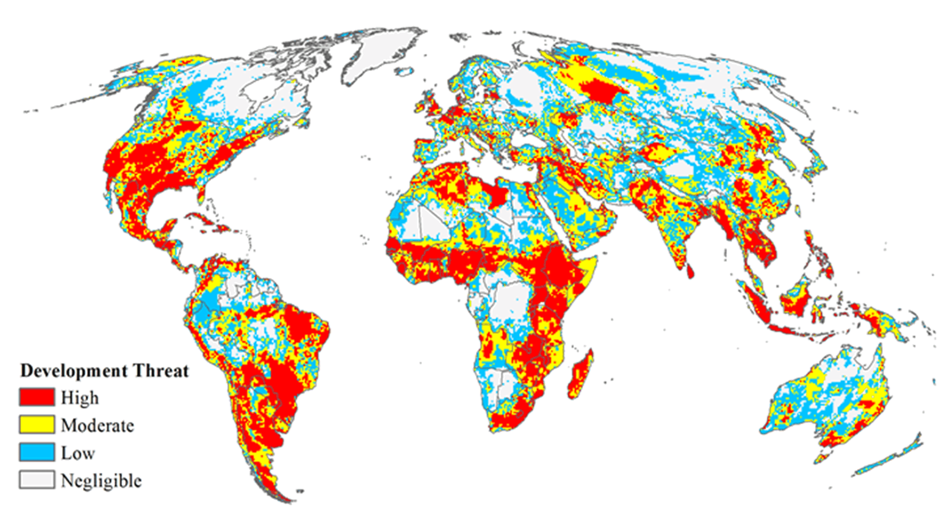
Too Hot to Handle: How Climate Change May Make Some Places Too Hot to Live
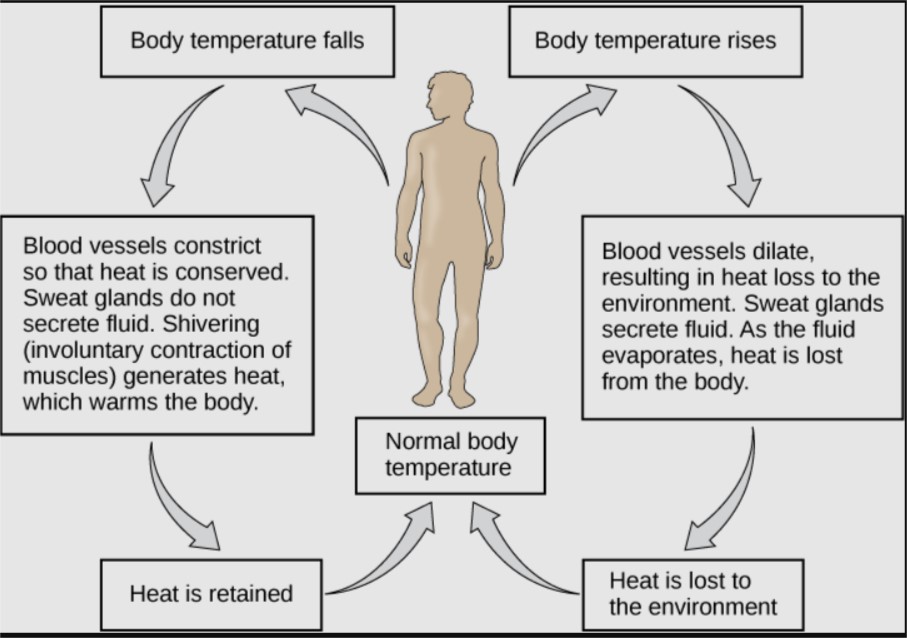 How hot is too hot? As Earth’s climate warms, heat waves are becoming more frequent and severe. The health dangers of extreme heat have scientists and medical experts increasingly concerned. And for good reason: heat stress is a leading cause of weather-related deaths in the United States each year. A recent example is the record-breaking heat wave that hit the U.S. Pacific Northwest last summer, killing hundreds….
How hot is too hot? As Earth’s climate warms, heat waves are becoming more frequent and severe. The health dangers of extreme heat have scientists and medical experts increasingly concerned. And for good reason: heat stress is a leading cause of weather-related deaths in the United States each year. A recent example is the record-breaking heat wave that hit the U.S. Pacific Northwest last summer, killing hundreds….Uninsurable Nation – Australia
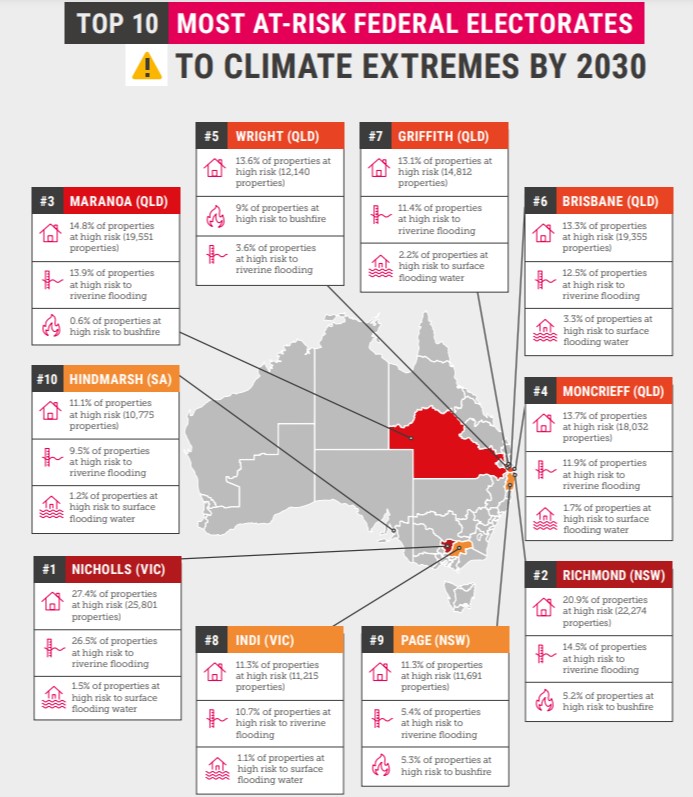
 2 May 2018. Bloomberg, …..Until recently, the guiding philosophy behind attempts to protect U.S. homes and cities against the effects of climate change was to build more defenses. Houses can be perched on stilts, surrounded by barriers, buttressed with storm proof windows and roofs. Neighborhoods can be buffered by seawalls for storm surges, levees for floods, firebreaks for wildfires. Defenses are an instinctive response for a species that’s evolved by taming the natural world. But sometimes the natural world won’t be tamed. Or, more precisely, sometimes engineered solutions can no longer withstand the unrelenting force of more water, more rain, more fires, more wind. Within 20 years, says the Union of Concerned Scientists, 170 cities and towns along the U.S. coast will be “chronically inundated,” which the group defines as flooding of at least 10 percent of a land area, on average, twice a month. By the end of the century, that category will grow to include more than half of the communities along the Eastern Seaboard and Gulf Coast—and that’s if the rate of climate change doesn’t accelerate. In their less guarded moments, officials in charge of this country’s disaster programs have begun to acknowledge the previously unthinkable: Sometimes the only effective way to protect people from climate change is to give up. Let nature reclaim the land and move a neighborhood out of harm’s way while it still is one. But even when all the most obvious ingredients are in place—from federal money and local buy-in to cheap, dry land right next door—moving is hard. Sidney has yet to remove more than a few dozen homes from the flood plain or break ground on land away from the river. Its failure so far illustrates how unprepared the U.S. is politically, financially, and emotionally to re-create even a single community away from rising waters in an organized way, preserving some semblance of its character and history. Read more here
2 May 2018. Bloomberg, …..Until recently, the guiding philosophy behind attempts to protect U.S. homes and cities against the effects of climate change was to build more defenses. Houses can be perched on stilts, surrounded by barriers, buttressed with storm proof windows and roofs. Neighborhoods can be buffered by seawalls for storm surges, levees for floods, firebreaks for wildfires. Defenses are an instinctive response for a species that’s evolved by taming the natural world. But sometimes the natural world won’t be tamed. Or, more precisely, sometimes engineered solutions can no longer withstand the unrelenting force of more water, more rain, more fires, more wind. Within 20 years, says the Union of Concerned Scientists, 170 cities and towns along the U.S. coast will be “chronically inundated,” which the group defines as flooding of at least 10 percent of a land area, on average, twice a month. By the end of the century, that category will grow to include more than half of the communities along the Eastern Seaboard and Gulf Coast—and that’s if the rate of climate change doesn’t accelerate. In their less guarded moments, officials in charge of this country’s disaster programs have begun to acknowledge the previously unthinkable: Sometimes the only effective way to protect people from climate change is to give up. Let nature reclaim the land and move a neighborhood out of harm’s way while it still is one. But even when all the most obvious ingredients are in place—from federal money and local buy-in to cheap, dry land right next door—moving is hard. Sidney has yet to remove more than a few dozen homes from the flood plain or break ground on land away from the river. Its failure so far illustrates how unprepared the U.S. is politically, financially, and emotionally to re-create even a single community away from rising waters in an organized way, preserving some semblance of its character and history. Read more here 28 August 2017, Desmog, 12 Years After Katrina, Hurricane Harvey Pummels Gulf Coast and Its Climate Science-Denying Politicians. As the remnants of Hurricane Harvey (now a tropical storm) continue to flood Houston — just days before the 12th anniversary of Hurricane Katrina — I visited Shannon Rainey, whose house was built on top of a Superfund site in the Upper Ninth Ward of New Orleans. Rainey is worried about family members in Houston. She knows all too well how long it can take to get back what is lost in a storm. “I still live with Katrina every day,” she told me. New Orleans remains threatened by bands of rain extending from Harvey, causing many residents with fierce memories of Katrina to remain on edge. Earlier this month, the city proved it was ill-prepared for hurricane season nearly a year after Baton Rouge’s 1,000-year flood. Rain inundated New Orleans, with more than nine inches falling in only three hours, exposing that the city’s pump system could not operate at full capacity. The city is still scrambling to make the needed repairs and clean the sewer system’s catch basins, which remain clogged in many places. Read More here
28 August 2017, Desmog, 12 Years After Katrina, Hurricane Harvey Pummels Gulf Coast and Its Climate Science-Denying Politicians. As the remnants of Hurricane Harvey (now a tropical storm) continue to flood Houston — just days before the 12th anniversary of Hurricane Katrina — I visited Shannon Rainey, whose house was built on top of a Superfund site in the Upper Ninth Ward of New Orleans. Rainey is worried about family members in Houston. She knows all too well how long it can take to get back what is lost in a storm. “I still live with Katrina every day,” she told me. New Orleans remains threatened by bands of rain extending from Harvey, causing many residents with fierce memories of Katrina to remain on edge. Earlier this month, the city proved it was ill-prepared for hurricane season nearly a year after Baton Rouge’s 1,000-year flood. Rain inundated New Orleans, with more than nine inches falling in only three hours, exposing that the city’s pump system could not operate at full capacity. The city is still scrambling to make the needed repairs and clean the sewer system’s catch basins, which remain clogged in many places. Read More here 20 April 2017, Bloomberg Climate Changed, The Nightmare Scenario for Florida’s Coastal Homeowners. Demand and financing could collapse before the sea consumes a single house. On a predictably gorgeous South Florida afternoon, Coral Gables Mayor Jim Cason sat in his office overlooking the white-linen restaurants of this affluent seaside community and wondered when climate change would bring it all to an end. He figured it would involve a boat. When Cason first started worrying about sea-level rise, he asked his staff to count not just how much coastline the city had (47 miles) or value of the property along that coast ($3.5 billion). He also told them to find out how many boats dock inland from the bridges that span the city’s canals (302). What matters, he guessed, will be the first time a mast fails to clear the bottom of one of those bridges because the water level had risen too far. “These boats are going to be the canary in the mine,” said Cason, who became mayor in 2011 after retiring from the U.S. foreign service. “When the boats can’t go out, the property values go down.” Jim Cason, mayor of Coral Gables, in his office. He worries that rising insurance costs, reluctant lenders or skittish foreign buyers could hurt home prices well before sea-level rise gets worse. If property values start to fall, Cason said, banks could stop writing 30-year mortgages for coastal homes, shrinking the pool of able buyers and sending prices lower still. Those properties make up a quarter of the city’s tax base; if that revenue fell, the city would struggle to provide the services that make it such a desirable place to live, causing more sales and another drop in revenue. And all of that could happen before the rising sea consumes a single home. As President Donald Trump proposes dismantling federal programs aimed at cutting greenhouse gas emissions, officials and residents in South Florida are grappling with the risk that climate change could drag down housing markets. Relative sea levels in South Florida are roughly four inches higher now than in 1992. The National Oceanic and Atmospheric Administration predicts sea levels will rise as much as three feet in Miami by 2060. By the end of the century, according to projections by Zillow, some 934,000 existing Florida properties, worth more than $400 billion, are at risk of being submerged. Read More here
20 April 2017, Bloomberg Climate Changed, The Nightmare Scenario for Florida’s Coastal Homeowners. Demand and financing could collapse before the sea consumes a single house. On a predictably gorgeous South Florida afternoon, Coral Gables Mayor Jim Cason sat in his office overlooking the white-linen restaurants of this affluent seaside community and wondered when climate change would bring it all to an end. He figured it would involve a boat. When Cason first started worrying about sea-level rise, he asked his staff to count not just how much coastline the city had (47 miles) or value of the property along that coast ($3.5 billion). He also told them to find out how many boats dock inland from the bridges that span the city’s canals (302). What matters, he guessed, will be the first time a mast fails to clear the bottom of one of those bridges because the water level had risen too far. “These boats are going to be the canary in the mine,” said Cason, who became mayor in 2011 after retiring from the U.S. foreign service. “When the boats can’t go out, the property values go down.” Jim Cason, mayor of Coral Gables, in his office. He worries that rising insurance costs, reluctant lenders or skittish foreign buyers could hurt home prices well before sea-level rise gets worse. If property values start to fall, Cason said, banks could stop writing 30-year mortgages for coastal homes, shrinking the pool of able buyers and sending prices lower still. Those properties make up a quarter of the city’s tax base; if that revenue fell, the city would struggle to provide the services that make it such a desirable place to live, causing more sales and another drop in revenue. And all of that could happen before the rising sea consumes a single home. As President Donald Trump proposes dismantling federal programs aimed at cutting greenhouse gas emissions, officials and residents in South Florida are grappling with the risk that climate change could drag down housing markets. Relative sea levels in South Florida are roughly four inches higher now than in 1992. The National Oceanic and Atmospheric Administration predicts sea levels will rise as much as three feet in Miami by 2060. By the end of the century, according to projections by Zillow, some 934,000 existing Florida properties, worth more than $400 billion, are at risk of being submerged. Read More here 29 August 2016, Bloomberg View, Last fall, two towns at opposite ends of the country entered a new kind of contest run by the federal government. At stake was their survival: Each is being consumed by the rising ocean, and winning money from Washington would mean the chance to move to higher ground. On the western edge of Alaska, the remote town of Newtok was losing50 to 100 feet of coastline each year to sea-level rise and melting permafrost. It was about to lose its drinking water, its school and maybe even its airport. Its 350 or so residents had been trying to move to safety for 20 years; in 2003, they obtained new land, about 10 miles to the south. Four thousand miles away on the Louisiana coast, another town, Isle de Jean Charles, was also starting to drown. It was home to just 25 families, some of whomremained ambivalent about relocating. It wasn’t losing land at the rate of Newtok. Its residents didn’t face the same risk of losing access to key facilities. And they had yet to select a new site, let alone secure the rights to it.
29 August 2016, Bloomberg View, Last fall, two towns at opposite ends of the country entered a new kind of contest run by the federal government. At stake was their survival: Each is being consumed by the rising ocean, and winning money from Washington would mean the chance to move to higher ground. On the western edge of Alaska, the remote town of Newtok was losing50 to 100 feet of coastline each year to sea-level rise and melting permafrost. It was about to lose its drinking water, its school and maybe even its airport. Its 350 or so residents had been trying to move to safety for 20 years; in 2003, they obtained new land, about 10 miles to the south. Four thousand miles away on the Louisiana coast, another town, Isle de Jean Charles, was also starting to drown. It was home to just 25 families, some of whomremained ambivalent about relocating. It wasn’t losing land at the rate of Newtok. Its residents didn’t face the same risk of losing access to key facilities. And they had yet to select a new site, let alone secure the rights to it.  7 April 2017, New York Times, GUANGZHOU, China — The rains brought torrents, pouring into basements and malls, the water swiftly rising a foot and a half. The city of Dongguan, a manufacturing center here in the world’s most dynamic industrial region, was hit especially hard by the downpour in May 2014. More than 100 factories and shops were inundated. Water climbed knee-high in 20 minutes, wiping out inventory for dozens of businesses. Next door in Guangzhou, an ancient, mammoth port city of 13 million, helicopters and a fleet of 80 boats had to be sent to rescue trapped residents. Tens of thousands lost their homes, and 53 square miles of nearby farmland were ruined. The cost of repairs topped $100 million. Chen Rongbo, who lived in the city, saw the flood coming. He tried to scramble to safety on the second floor of his house, carrying his 6-year-old granddaughter. He slipped. The flood swept both of them away. Flooding has been a plague for centuries in southern China’s Pearl River Delta. So even the rains that May, the worst in the area in years, soon drifted from the headlines. People complained and made jokes on social media about wading through streets that had become canals and riding on half-submerged buses through lakes that used to be streets. But there was no official hand-wringing about what caused the floods or how climate change might bring more extreme storms and make the problems worse. Read More here
7 April 2017, New York Times, GUANGZHOU, China — The rains brought torrents, pouring into basements and malls, the water swiftly rising a foot and a half. The city of Dongguan, a manufacturing center here in the world’s most dynamic industrial region, was hit especially hard by the downpour in May 2014. More than 100 factories and shops were inundated. Water climbed knee-high in 20 minutes, wiping out inventory for dozens of businesses. Next door in Guangzhou, an ancient, mammoth port city of 13 million, helicopters and a fleet of 80 boats had to be sent to rescue trapped residents. Tens of thousands lost their homes, and 53 square miles of nearby farmland were ruined. The cost of repairs topped $100 million. Chen Rongbo, who lived in the city, saw the flood coming. He tried to scramble to safety on the second floor of his house, carrying his 6-year-old granddaughter. He slipped. The flood swept both of them away. Flooding has been a plague for centuries in southern China’s Pearl River Delta. So even the rains that May, the worst in the area in years, soon drifted from the headlines. People complained and made jokes on social media about wading through streets that had become canals and riding on half-submerged buses through lakes that used to be streets. But there was no official hand-wringing about what caused the floods or how climate change might bring more extreme storms and make the problems worse. Read More here 17 February 2017, New York Times, Mexico City, Parched and Sinking, Faces a Water Crisis. MEXICO CITY — On bad days, you can smell the stench from a mile away, drifting over a nowhere sprawl of highways and office parks. When the Grand Canal was completed, at the end of the 1800s, it was Mexico City’s Brooklyn Bridge, a major feat of engineering and a symbol of civic pride: 29 miles long, with the ability to move tens of thousands of gallons of wastewater per second. It promised to solve the flooding and sewage problems that had plagued the city for centuries. Only it didn’t, pretty much from the start. The canal was based on gravity. And Mexico City, a mile and a half above sea level, was sinking, collapsing in on itself. It still is, faster and faster, and the canal is just one victim of what has become a vicious cycle. Always short of water, Mexico City keeps drilling deeper for more, weakening the ancient clay lake beds on which the Aztecs first built much of the city, causing it to crumble even further. It is a cycle made worse by climate change. More heat and drought mean more evaporation and yet more demand for water, adding pressure to tap distant reservoirs at staggering costs or further drain underground aquifers and hasten the city’s collapse. In the immense neighborhood of Iztapalapa — where nearly two million people live, many of them unable to count on water from their taps — a teenager was swallowed up where a crack in the brittle ground split open a street. Sidewalks resemble broken china, and 15 elementary schools have crumbled or caved in. Much is being written about climate change and the impact of rising seas on waterfront populations. But coasts are not the only places affected. Mexico City — high in the mountains, in the center of the country — is a glaring example. The world has a lot invested in crowded capitals like this one, with vast numbers of people, huge economies and the stability of a hemisphere at risk.Read More here
17 February 2017, New York Times, Mexico City, Parched and Sinking, Faces a Water Crisis. MEXICO CITY — On bad days, you can smell the stench from a mile away, drifting over a nowhere sprawl of highways and office parks. When the Grand Canal was completed, at the end of the 1800s, it was Mexico City’s Brooklyn Bridge, a major feat of engineering and a symbol of civic pride: 29 miles long, with the ability to move tens of thousands of gallons of wastewater per second. It promised to solve the flooding and sewage problems that had plagued the city for centuries. Only it didn’t, pretty much from the start. The canal was based on gravity. And Mexico City, a mile and a half above sea level, was sinking, collapsing in on itself. It still is, faster and faster, and the canal is just one victim of what has become a vicious cycle. Always short of water, Mexico City keeps drilling deeper for more, weakening the ancient clay lake beds on which the Aztecs first built much of the city, causing it to crumble even further. It is a cycle made worse by climate change. More heat and drought mean more evaporation and yet more demand for water, adding pressure to tap distant reservoirs at staggering costs or further drain underground aquifers and hasten the city’s collapse. In the immense neighborhood of Iztapalapa — where nearly two million people live, many of them unable to count on water from their taps — a teenager was swallowed up where a crack in the brittle ground split open a street. Sidewalks resemble broken china, and 15 elementary schools have crumbled or caved in. Much is being written about climate change and the impact of rising seas on waterfront populations. But coasts are not the only places affected. Mexico City — high in the mountains, in the center of the country — is a glaring example. The world has a lot invested in crowded capitals like this one, with vast numbers of people, huge economies and the stability of a hemisphere at risk.Read More here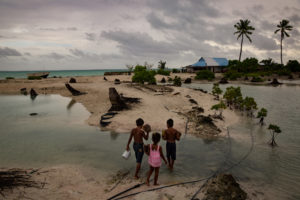 May 2016, Carbon Casualties, New York times,TARAWA, Kiribati — One clear bright day last winter, a tidal surge swept over an ocean embankment here in the remote, low-lying island country of Kiribati, smashing through the doors and windows of Betio Hospital and spewing sand and debris across its maternity ward. Beero Hosea, 37, a handyman, cut the power and helped carry frightened mothers through the rubble and water to a nearby school. “If the next one is combined with a storm and stronger winds, that’s the end of us,” he said. “It’s going to cover this whole island.” For years, scientists have been predicting that much of Kiribati may become uninhabitable within decades because of an onslaught of environmental problems linked to climate change. And for just as long, many here have paid little heed. But while scientists are reluctant to attribute any specific weather or tidal event to rising sea levels, the tidal surge last winter, known as a king tide, was a chilling wake-up call. “It shocked us,” said Tean Rube, a pastor with the Kiribati Uniting Church. “We realized, O.K., maybe climate change is real.” Read More here
May 2016, Carbon Casualties, New York times,TARAWA, Kiribati — One clear bright day last winter, a tidal surge swept over an ocean embankment here in the remote, low-lying island country of Kiribati, smashing through the doors and windows of Betio Hospital and spewing sand and debris across its maternity ward. Beero Hosea, 37, a handyman, cut the power and helped carry frightened mothers through the rubble and water to a nearby school. “If the next one is combined with a storm and stronger winds, that’s the end of us,” he said. “It’s going to cover this whole island.” For years, scientists have been predicting that much of Kiribati may become uninhabitable within decades because of an onslaught of environmental problems linked to climate change. And for just as long, many here have paid little heed. But while scientists are reluctant to attribute any specific weather or tidal event to rising sea levels, the tidal surge last winter, known as a king tide, was a chilling wake-up call. “It shocked us,” said Tean Rube, a pastor with the Kiribati Uniting Church. “We realized, O.K., maybe climate change is real.” Read More here
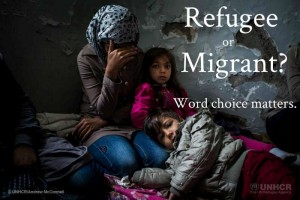 Which is right? With almost 60 million people forcibly displaced globally and boat crossings of the Mediterranean in the headlines almost daily, it is becoming increasingly common to see the terms ‘refugee’ and ‘migrant’ being used interchangeably in media and public discourse. But is there a difference between the two, and does it matter? Yes, there is a difference, and it does matter. The two terms have distinct and different meanings, and confusing them leads to problems for both populations. Here’s why: Refugees are persons fleeing armed conflict or persecution. There were 19.5 million of them worldwide at the end of 2014. Their situation is often so perilous and intolerable that they cross national borders to seek safety in nearby countries, and thus become internationally recognized as “refugees” with access to assistance from States, UNHCR, and other organizations. They are so recognized precisely because it is too dangerous for them to return home, and they need sanctuary elsewhere. These are people for whom denial of asylum has potentially deadly consequences. Migrants choose to move not because of a direct threat of persecution or death, but mainly to improve their lives by finding work, or in some cases for education, family reunion, or other reasons. Unlike refugees who cannot safely return home, migrants face no such impediment to return. If they choose to return home, they will continue to receive the protection of their government….For individual governments, this distinction is important. Countries deal with migrants under their own immigration laws and processes. Countries deal with refugees through norms of refugee protection and asylum that are defined in both national legislation and international law. Countries have specific responsibilities towards anyone seeking asylum on their territories or at their borders. UNHCR helps countries deal with their asylum and refugee protection responsibilities…. Politics has a way of intervening in such debates. Conflating refugees and migrants can have serious consequences for the lives and safety of refugees. Blurring the two terms takes attention away from the specific legal protections refugees require. It can undermine public support for refugees and the institution of asylum at a time when more refugees need such protection than ever before. We need to treat all human beings with respect and dignity. We need to ensure that the human rights of migrants are respected. At the same time, we also need to provide an appropriate legal response for refugees, because of their particular predicament. Read More here
Which is right? With almost 60 million people forcibly displaced globally and boat crossings of the Mediterranean in the headlines almost daily, it is becoming increasingly common to see the terms ‘refugee’ and ‘migrant’ being used interchangeably in media and public discourse. But is there a difference between the two, and does it matter? Yes, there is a difference, and it does matter. The two terms have distinct and different meanings, and confusing them leads to problems for both populations. Here’s why: Refugees are persons fleeing armed conflict or persecution. There were 19.5 million of them worldwide at the end of 2014. Their situation is often so perilous and intolerable that they cross national borders to seek safety in nearby countries, and thus become internationally recognized as “refugees” with access to assistance from States, UNHCR, and other organizations. They are so recognized precisely because it is too dangerous for them to return home, and they need sanctuary elsewhere. These are people for whom denial of asylum has potentially deadly consequences. Migrants choose to move not because of a direct threat of persecution or death, but mainly to improve their lives by finding work, or in some cases for education, family reunion, or other reasons. Unlike refugees who cannot safely return home, migrants face no such impediment to return. If they choose to return home, they will continue to receive the protection of their government….For individual governments, this distinction is important. Countries deal with migrants under their own immigration laws and processes. Countries deal with refugees through norms of refugee protection and asylum that are defined in both national legislation and international law. Countries have specific responsibilities towards anyone seeking asylum on their territories or at their borders. UNHCR helps countries deal with their asylum and refugee protection responsibilities…. Politics has a way of intervening in such debates. Conflating refugees and migrants can have serious consequences for the lives and safety of refugees. Blurring the two terms takes attention away from the specific legal protections refugees require. It can undermine public support for refugees and the institution of asylum at a time when more refugees need such protection than ever before. We need to treat all human beings with respect and dignity. We need to ensure that the human rights of migrants are respected. At the same time, we also need to provide an appropriate legal response for refugees, because of their particular predicament. Read More here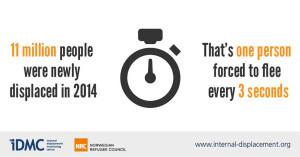
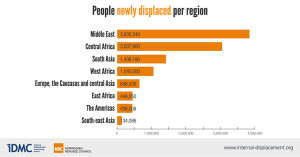 “We know that more and more internally displaced have been forced to move within their country multiple times. The longer a conflict lasts, the more insecure they feel and when hopelessness sets in, many will cross borders and become refugees,” he said.
“We know that more and more internally displaced have been forced to move within their country multiple times. The longer a conflict lasts, the more insecure they feel and when hopelessness sets in, many will cross borders and become refugees,” he said. 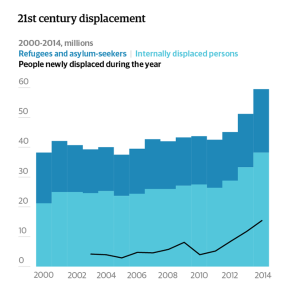 18 June 2015, The Guardian, War, violence and persecution left one in every 122 humans on the planet a refugee, internally displaced or seeking asylum at the end of last year, according to a stark UN report that warns the world is failing the victims of an “age of unprecedented mass displacement”. The annual global trends study by the UN’s refugee agency, UNHCR, finds that the level of worldwide displacement is higher than ever before, with a record 59.5 million people living exiled from their homes at the end of 2014. UNHCR estimates that an average of 42,500 men, women and children became refugees, asylum seekers or internally displaced people every day last year – a four-fold increase in just four years. Read More here
18 June 2015, The Guardian, War, violence and persecution left one in every 122 humans on the planet a refugee, internally displaced or seeking asylum at the end of last year, according to a stark UN report that warns the world is failing the victims of an “age of unprecedented mass displacement”. The annual global trends study by the UN’s refugee agency, UNHCR, finds that the level of worldwide displacement is higher than ever before, with a record 59.5 million people living exiled from their homes at the end of 2014. UNHCR estimates that an average of 42,500 men, women and children became refugees, asylum seekers or internally displaced people every day last year – a four-fold increase in just four years. Read More here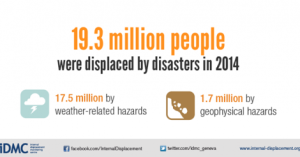 July 2015, IDMC, Global Estimates 2015 of people displaced by disasters: Latest figures from IDMC estimate that more than 19.3 million people were forced to flee their homes by disasters in 100 countries in 2014. Hundreds of thousands more are still displaced following disasters in previous years. Since 2008, an average of 26.4 million people per year have been displaced from their homes by disasters brought on by natural hazards. This is the equivalent to one person being displaced every second. The number and scale of huge disasters creates significant fluctuation from year to year in the total number of people displaced, while the trend over decades is on the rise.
July 2015, IDMC, Global Estimates 2015 of people displaced by disasters: Latest figures from IDMC estimate that more than 19.3 million people were forced to flee their homes by disasters in 100 countries in 2014. Hundreds of thousands more are still displaced following disasters in previous years. Since 2008, an average of 26.4 million people per year have been displaced from their homes by disasters brought on by natural hazards. This is the equivalent to one person being displaced every second. The number and scale of huge disasters creates significant fluctuation from year to year in the total number of people displaced, while the trend over decades is on the rise.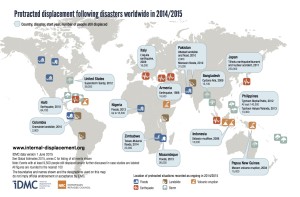 The common assumption that displacement following disasters is short-term and temporary does not hold true in many cases. The cases we identified highlight the plight of people, some of whom have been living in protracted displacement for up to 26 years. A sample of 34 ongoing cases accounts for more than 715,000 people stuck in limbo, and points to the likelihood of hundreds of thousands more who have not yet been recorded. Most of the cases of protracted displacement we identified are in low and middle-income developing countries, but there are also significant examples in rich countries, such as the US and Japan. Vulnerable and marginalised people in high-income countries also risk being excluded from solutions. People in such situations receive little attention and are likely to be left behind in long-term recovery, disaster risk reduction and development processes. Read More here Read full report here
The common assumption that displacement following disasters is short-term and temporary does not hold true in many cases. The cases we identified highlight the plight of people, some of whom have been living in protracted displacement for up to 26 years. A sample of 34 ongoing cases accounts for more than 715,000 people stuck in limbo, and points to the likelihood of hundreds of thousands more who have not yet been recorded. Most of the cases of protracted displacement we identified are in low and middle-income developing countries, but there are also significant examples in rich countries, such as the US and Japan. Vulnerable and marginalised people in high-income countries also risk being excluded from solutions. People in such situations receive little attention and are likely to be left behind in long-term recovery, disaster risk reduction and development processes. Read More here Read full report here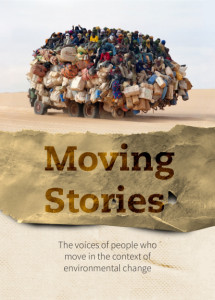 7 February 2014, COIN (UK) Moving Stories report: This report highlights powerful, inspiring and often traumatic stories. Testimonies from ten regions across the world have been compiled from local news reports, academic journals and interviews recorded by civil society groups. The stories highlight different kinds of movement affected by slow– and rapid–onset disasters. The stories show us that movement linked to environmental change happens very differently in different parts of the world. The stories also reveal that individual decisions to move or stay vary widely even in response to the same disaster. There is no “typical” migrant. Moving Stories demonstrate the reality of migration and environmental change. A number of stories show how people have used moving seasonally and temporarily, rather than permanently, as a way of adapting to changing environmental conditions. Several stories demonstrate that remittances from other migrants have increased the resilience of people affected by disasters. Most importantly these testimonies give a human voice to this complex and controversial issue…. How can moving become an empowering way for some people to adapt to climate change? What is the role of remittances in building resilience to climate change? Will our existing legal frameworks for protecting the rights of people who move be up to the job in a generation’s time? Go here to download report
7 February 2014, COIN (UK) Moving Stories report: This report highlights powerful, inspiring and often traumatic stories. Testimonies from ten regions across the world have been compiled from local news reports, academic journals and interviews recorded by civil society groups. The stories highlight different kinds of movement affected by slow– and rapid–onset disasters. The stories show us that movement linked to environmental change happens very differently in different parts of the world. The stories also reveal that individual decisions to move or stay vary widely even in response to the same disaster. There is no “typical” migrant. Moving Stories demonstrate the reality of migration and environmental change. A number of stories show how people have used moving seasonally and temporarily, rather than permanently, as a way of adapting to changing environmental conditions. Several stories demonstrate that remittances from other migrants have increased the resilience of people affected by disasters. Most importantly these testimonies give a human voice to this complex and controversial issue…. How can moving become an empowering way for some people to adapt to climate change? What is the role of remittances in building resilience to climate change? Will our existing legal frameworks for protecting the rights of people who move be up to the job in a generation’s time? Go here to download reportGlobal Poverty
Health Issues
